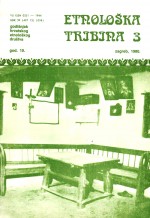Tekstilno rukotvorstvo uže okolice Zagreba
Textile Handicraft from the Surroundings of Zagreb
Author(s): Nerina EckhelSubject(s): Cultural Anthropology / Ethnology, Rural and urban sociology, Post-War period (1950 - 1989)
Published by: Hrvatsko etnološko društvo
Keywords: textile handicraft; Resnik; Čučerje; Markuševac; Šestine; weaver; urbanization;
Summary/Abstract: The villages of Resnik, Čučerje, Markuševac and Šestine, in which the research was conducted by the Ethnographic Museum between 1969 and 1979, are located north and southeast of Zagreb, and are ever more becoming its constituent parts. The traditional textile handiwork of the investigated area has a lot of common features, but there are some specifics too. The procurement of raw materials for weaving, and their processing, was the same in all these villages; some elements which were common for all of northwestern Croatia also appeared here. Thus, all four villages had the same tools for the processing of raw textile plants, and the same weaving tools (the horizontal type of loom, for instance). Hemp was grown in the area, while flax, cotton thread and silk had to be bought. The villages differed in division of labor related to hand-making textile. In Markuševac and Šestine there were male semi-professional weavers, in Resnik and Šćitarjevo weavers were exclusively women, while Čučerje had both variants. There, women were weaving textile for costumes, while men were making material for tablecloths, towels and bedding. They used different weaving techniques and decorations. Men’s products have decorative strips in countless variants; women’s ornaments are more elaborate, having a rich scale of colors and regular geometric or stylized floral motifs. The data reported on here could be collected only from people above forty years old. The process of withdrawal from textile handicraft in the described area started between World War I and World War II, and was completed by the 1950's. Main causes for this were the transformation of large family households (zadruge) to nuclear family households and the increasing employment in industry together with the decline of peasant family economy in general. One of the accompanying changes was switch from traditional clothes to more urban-style clothes, while other textile articles in the household were gradually replaced by those produced industrially.
Journal: Etnološka tribina : Godišnjak Hrvatskog etnološkog društva
- Issue Year: 1980
- Issue No: 10
- Page Range: 27-38
- Page Count: 14
- Language: Croatian

